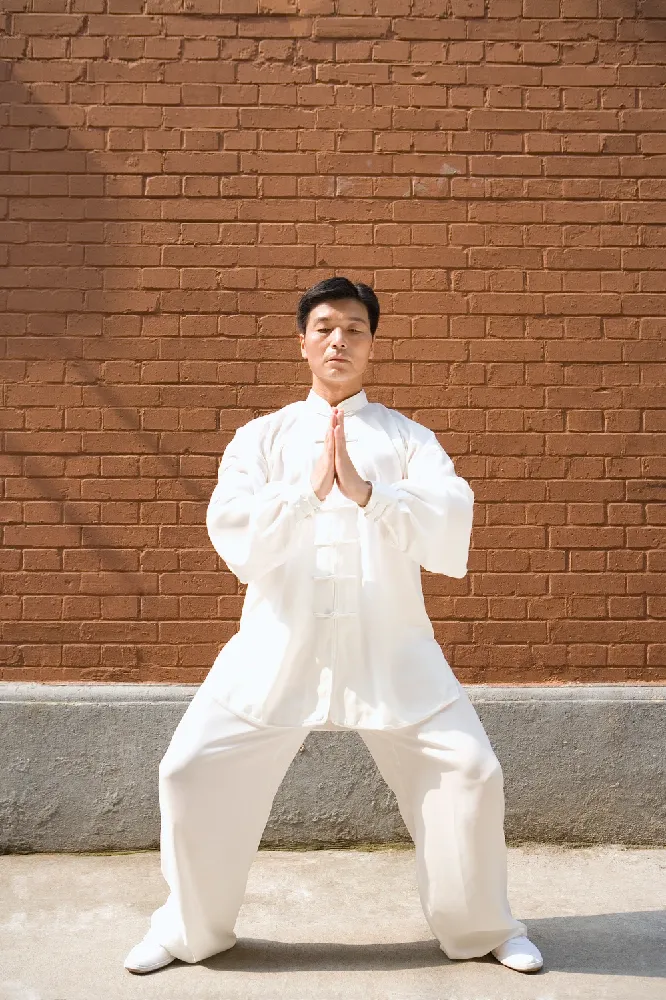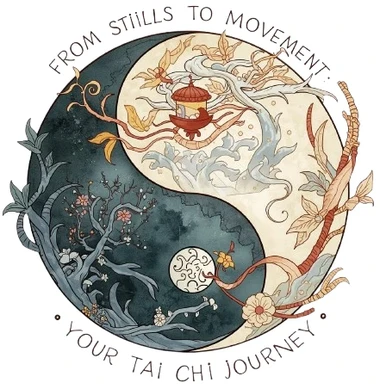“It’s often labeled as a ‘gentle exercise,’ but to dismiss Tai Chi as merely slow-moving is to miss its profound power.”
I used to think Tai Chi was just for seniors in the park.
Slow steps. Floating arms. Peaceful, yes—but was it really exercise?
Turns out, I was wrong. And not just a little wrong.
Modern science is now confirming what Tai Chi practitioners have known for centuries: this ancient art is a potent tool for transforming health—from head to toe, inside and out.
So if you’ve ever wondered, “Is Tai Chi good for you?”—this article is for you.
We’re diving deep into 10 evidence-based Tai Chi benefits, backed by research from institutions like Harvard Health, Mayo Clinic, and peer-reviewed journals.
And we won’t stop at the science. I’ll show you how to actually get these benefits—step by step, breath by breath.

How We Chose These Benefits
Let’s be clear: this isn’t a list based on anecdotes or ancient legends.
Every benefit here is supported by clinical trials, systematic reviews, or expert consensus.
We looked at studies from Harvard Health Publishing, the New England Journal of Medicine, and a massive review of 210 clinical trials published in Systematic Reviews.
These benefits aren’t isolated. Tai Chi works holistically—through slow, mindful movement, deep breathing, and focused attention.
It’s not just physical. It’s neurological. Emotional. Energetic.
Exclusive Tip: When reading about these benefits, don’t just think “science.” Think “synergy.”
Tai Chi heals through connection—between breath and body, mind and motion. Start Your Tai Chi Journey Here.
Quick Overview: 10 Proven Tai Chi Benefits
| # | Benefit | Description |
|---|---|---|
| 1 | Better Balance | Strengthens legs and improves body awareness to prevent falls. |
| 2 | Stress Relief | Calms the nervous system and lowers cortisol levels. |
| 3 | Pain Reduction | Eases joint and back pain through gentle movement. |
| 4 | Heart Health | Helps regulate blood pressure and improves circulation. |
| 5 | Brain Boost | Enhances memory, focus, and cognitive function. |
| 6 | Deeper Sleep | Promotes relaxation and better sleep quality. |
| 7 | Stronger Immunity | Supports immune response and reduces inflammation. |
| 8 | Muscle Strength | Builds endurance and tones stabilizer muscles. |
| 9 | Parkinson’s Support | Improves gait, balance, and motor control. |
| 10 | Emotional Well-being | Reduces anxiety and lifts mood through mindful movement. |
Significantly Improves Balance and Prevents Falls
A study in the New England Journal of Medicine found that Tai Chi reduced falls among older adults by 45%. That’s not a small number. That’s life-changing.
Why? Because Tai Chi strengthens the ankles, knees, and core. It improves proprioception—your ability to sense where your body is in space. And it teaches you how to shift weight slowly and safely.
If you’re a senior, or someone with neurological challenges, this is gold.
How to Get It: Practice movements like “Golden Rooster Stands on One Leg” and “Wave Hands Like Clouds.” Focus on slow weight transfers and single-leg stances. Even 10 minutes a day helps.
Exclusive Tip: Try standing on one leg while brushing your teeth. It’s a playful way to build balance into your routine. Tai Chi for Balance: The Ultimate Guide to Fall Prevention and Stability.
Reduces Stress and Anxiety
Tai Chi is often called “meditation in motion.” But it’s more than poetic. It’s physiological.
Studies show Tai Chi lowers cortisol—the stress hormone—and activates the parasympathetic nervous system. That means slower heart rate, calmer breath, and a quieter mind.
In one study, patients practicing 24-form Tai Chi showed reduced anxiety and depression symptoms, along with improved biomarkers.
How to Get It: Focus on breath. Let each inhale expand your belly. Let each exhale soften your shoulders. Use flowing forms like “Cloud Hands” to sync breath and movement.
Exclusive Tip: Practice Tai Chi outdoors. Nature amplifies the calming effect. Even a small garden or balcony works. Tai Chi for Stress Relief: A Practical Guide to Finding Calm in Motion.
Eases Chronic Pain (Especially Back and Joint Pain)
If you’ve got arthritis, fibromyalgia, or persistent back pain, Tai Chi might be your missing piece.
A systematic review found Tai Chi significantly reduced pain intensity and improved physical function in patients with knee osteoarthritis and chronic low back pain.
Why? Because Tai Chi strengthens muscles without strain. It improves joint mobility without impact. And it teaches you to move with awareness, not force.
How to Get It: Start with gentle forms. Avoid deep stances or fast transitions. Use movements like “Parting the Wild Horse’s Mane” to open the hips and spine.
Exclusive Tip: Pair Tai Chi with warm water therapy or gentle stretching. The combination can be surprisingly effective.
Boosts Heart Health
Tai Chi isn’t cardio in the traditional sense. But don’t let that fool you.
Studies show Tai Chi lowers blood pressure, improves cholesterol levels, and enhances circulation. It’s especially helpful for people with hypertension or recovering from cardiac events.
In one trial, Tai Chi practitioners showed reduced LDL (bad cholesterol), lower triglycerides, and improved quality of life scores.
How to Get It: Use continuous forms like the Yang 24 or 108. Keep your breath slow and steady. Let your movements flow without pause.
Exclusive Tip: Monitor your pulse before and after practice. You’ll be surprised how gently Tai Chi trains your cardiovascular system.
Enhances Cognitive Function
Tai Chi isn’t just good for the body. It’s food for the brain.
Research shows Tai Chi improves memory, attention, and executive function—especially in older adults with mild cognitive impairment.
One study found that Tai Chi practitioners had enhanced brain network connectivity and white matter integrity compared to walkers.
Why? Because Tai Chi combines movement, breath, and mental focus. It’s like doing a puzzle while dancing.
How to Get It: Learn and memorize a full form. Practice it regularly. Challenge yourself to recall each movement without visual cues.
Exclusive Tip: Try teaching a form to someone else. Explaining reinforces memory—and builds community.
Improves Sleep Quality
If you’ve ever stared at the ceiling at 2 a.m., mind racing, body restless—Tai Chi might be your remedy.
Multiple studies show that regular Tai Chi practice improves sleep duration, efficiency, and quality. In one randomized trial, older adults with insomnia who practiced Tai Chi slept better than those who took sleep education classes.
Why does it work? Because Tai Chi calms the nervous system, reduces cortisol, and gently tires the body without overstimulation. It’s like winding down with movement instead of medication.
How to Get It: Practice in the evening. Use slow, repetitive forms like “Wave Hands Like Clouds.” Focus on breath. Let each exhale soften your body. End with Wuji stance for 2 minutes.
Exclusive Tip: Try combining Tai Chi with a warm herbal tea ritual. The pairing creates a powerful signal to your body: it’s time to rest. Tai Chi for Sleep: A Gentle Path to Beating Insomnia and Improving Sleep Quality.
Strengthens the Immune System
This one surprised me. I didn’t expect Tai Chi to affect immunity. But the science says otherwise.
A UCLA study found that older adults practicing Tai Chi had a stronger antibody response to the shingles vaccine than those who didn’t. Other research shows increased T-cell activity and reduced inflammation markers.
How? Tai Chi reduces chronic stress, which suppresses immunity. It also improves circulation and lymphatic flow—key for immune function.
How to Get It: Consistency is key. Practice 3–4 times a week, even for 20 minutes. Use breath-focused forms and include standing meditation (Zhan Zhuang) to activate internal energy.
Exclusive Tip: Visualize your breath as light moving through your body. It’s not magic—it’s mindfulness. And it helps.
Builds Muscle Strength and Endurance
Tai Chi may look soft, but it builds strength in sneaky ways.
A study from the University of Hong Kong found that Tai Chi improved lower body strength and endurance in sedentary adults. The slow, controlled movements engage stabilizer muscles often ignored in gym workouts.
You’re not lifting weights—but you’re lifting yourself. Over and over. With intention.
How to Get It: Use deeper stances. Practice “Brush Knee and Twist Step” and “Repulse Monkey.” Hold postures for a few seconds longer. Feel the burn—but stay relaxed.
Exclusive Tip: Track your progress. Time how long you can hold “Horse Stance” comfortably. Watch that number grow.
Helps Manage Parkinson’s Disease Symptoms
Tai Chi isn’t a cure—but it’s a powerful support.
A landmark study published in the New England Journal of Medicine showed that Tai Chi improved balance, gait, and motor control in people with Parkinson’s disease. Participants also reported fewer falls and better quality of life.
Why? Because Tai Chi trains slow, intentional movement. It improves coordination, posture, and confidence.
How to Get It: Start with simplified forms. Use movements that emphasize weight shifting and trunk rotation. Practice with a teacher familiar with neurological conditions.
Exclusive Tip: Use a mirror. Watching yourself move builds awareness—and helps retrain the brain.
Enhances Mental Health and Emotional Well-being
This benefit ties everything together.
Tai Chi reduces depression, boosts mood, and increases overall life satisfaction. It’s not just the movement—it’s the mindfulness, the breath, the community.
In one meta-analysis, Tai Chi was found to be as effective as cognitive behavioral therapy for mild depression. That’s huge.
How to Get It: Practice with others. Join a class or online group. Use forms that feel expressive—like “White Crane Spreads Its Wings.” Let your emotions move through you.
Exclusive Tip: After each session, write down one word that describes how you feel. Over time, you’ll see a shift—from scattered to centered. Tai Chi for Weight Loss: The Gentle Yet Powerful Path to a Healthier You.

How to Actually Experience These Tai Chi Benefits
You don’t need to practice for hours. You don’t need to master the 108-form. You just need to show up—consistently, gently, with curiosity.
Start Small
Begin with 2–3 sessions per week. Each session can be 20–30 minutes. Even 10 minutes helps.
Be Patient
Some benefits show up quickly—like stress relief. Others, like improved balance or heart health, take 6–8 weeks. Stay with it.
Choose Wisely
Pick forms that match your goals. Want better sleep? Use calming movements. Want strength? Use deeper stances.
Track Progress
Keep a journal. Note how you feel before and after each session. Over time, you’ll see patterns—and progress.
Exclusive Tip: Don’t wait for motivation. Schedule your practice like a meeting with yourself. You deserve that time.
Tai Chi Benefits: Busting the Myths
Let’s pause for a moment and clear the air. Because despite all the science, Tai Chi still carries a few stubborn myths.
And if you’re new to this practice, they might be holding you back.
Myth 1: “Tai Chi is only for seniors.”
Yes, it’s popular among older adults—and for good reason. But Tai Chi is for everyone. Athletes use it to improve coordination. Busy professionals use it to manage stress. Teens use it to calm anxiety. If you have a body and a breath, Tai Chi is for you.
Myth 2: “It’s not real exercise.”
Tai Chi may not leave you drenched in sweat, but it trains strength, flexibility, endurance, and focus. Studies show it improves cardiovascular health, builds muscle, and enhances balance. It’s low-impact, but high-value.
Myth 3: “You have to be spiritual to do Tai Chi.”
Tai Chi has philosophical roots, yes. But you don’t need to believe anything to benefit. You just need to show up, breathe, and move. The rest unfolds naturally.
Exclusive Tip: If someone dismisses Tai Chi as “too slow,” invite them to try holding “Horse Stance” for 60 seconds. That usually changes the conversation.
Tai Chi Is a Practice, Not a Performance
Here’s something I wish I’d known earlier: you don’t have to be good at Tai Chi to benefit from it.
You don’t need perfect posture. You don’t need to memorize long forms. You don’t even need to feel “Zen” every time you practice.
Tai Chi meets you where you are. Whether you’re stressed, stiff, tired, or distracted—it welcomes you. And with each breath, each movement, it gently guides you back to center.
It’s not about performance. It’s about presence.
Exclusive Tip: If you miss a day, don’t feel guilty. Just start again. Tai Chi is patient. It waits for you.
How to Start Experiencing Tai Chi Benefits Today
You’ve read the science. You’ve seen the possibilities.
Now let’s make it real. Getting Started with Tai Chi / Tai Chi Fundamentals.
Step 1: Choose Your Focus
What benefit matters most to you right now?
- Better balance?
- Less stress?
- Improved sleep?
- Pain relief?
Start there. Let your goal guide your practice.
Step 2: Pick a Simple Routine
You don’t need the full 108-form. Start with 5–10 movements. Forms like “Commencement,” “Cloud Hands,” and “White Crane Spreads Its Wings” are beginner-friendly and effective.
Step 3: Schedule Your Practice
Consistency beats intensity. Aim for 2–3 sessions per week, 20–30 minutes each. Morning or evening—whatever fits your rhythm.
Step 4: Track Your Progress
Keep a journal. Write down how you feel before and after each session. Over time, you’ll notice patterns. Improvements. Insights.
Step 5: Stay Curious
Tai Chi is a lifelong journey. Explore breathing techniques. Try standing meditation. Learn about the philosophy. Let it unfold.
Exclusive Tip: Don’t practice alone forever. Join a class, online or in person. Community adds depth, accountability, and joy.
Conclusion: Your Health Is Waiting
Tai Chi isn’t just movement. It’s medicine. It’s mindfulness. It’s a quiet revolution in how we care for ourselves.
From better balance to deeper sleep, from reduced anxiety to stronger immunity—Tai Chi offers a path to health that’s gentle, sustainable, and scientifically sound.
And the best part? You don’t need to be flexible. You don’t need fancy gear. You don’t need hours of free time.
You just need a few feet of space. A few minutes of breath. And a willingness to begin.
So if you’ve ever asked, “Is Tai Chi good for you?”—now you know. It’s not just good. It’s transformative.
Still unsure where to begin?
Take our 2-minute Health Goals Quiz to discover the perfect Tai Chi path for your needs.
Ready to experience these benefits firsthand?
Explore our structured programs inside the Taichi Academy, designed to guide you toward better balance, less stress, and lasting wellness.
Your journey starts with one breath.
Let it begin today. --> The Complete Beginner's Guide to Tai Chi.
FAQ: Tai Chi Benefits and Scientific Insights
What are the top health benefits of Tai Chi according to science?
Scientific studies confirm that Tai Chi improves balance, reduces stress, strengthens the heart, and enhances mental health. It also helps with chronic pain, sleep quality, and immune function. These health benefits of Tai Chi are supported by research from Harvard, Mayo Clinic, and peer-reviewed journals.
Can Tai Chi really help with anxiety and stress?
Yes. Tai Chi activates the parasympathetic nervous system, lowers cortisol, and promotes calm. Many people use Tai Chi for anxiety and emotional regulation. It’s like moving meditation—gentle, rhythmic, and deeply soothing.
Is Tai Chi effective for seniors or people with limited mobility?
Absolutely. Tai Chi for seniors is one of the most researched areas. It improves balance, prevents falls, and enhances joint mobility. Even seated or modified forms can deliver benefits safely and effectively.
How does Tai Chi support heart health and circulation?
Tai Chi gently improves cardiovascular function. Studies show it lowers blood pressure, reduces LDL cholesterol, and enhances circulation. Practicing Tai Chi for heart health is especially helpful for people with hypertension or recovering from cardiac events.
How often should I practice Tai Chi to see results?
Consistency matters more than intensity. Practicing 2–3 times a week for 20–30 minutes can lead to noticeable improvements in balance, mood, and sleep within 4–8 weeks. Long-term benefits grow with regular practice.
